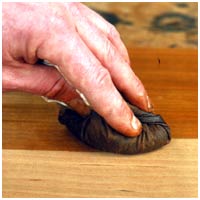How antique furniture was finished.
In the 17th century it have been the practice to finish oak furniture by means of rubbing in poppy or linseed oil, often dyed with alkanet root. Subsequently beeswax and turpentine finish was used to keep surfaces in good condition and to preserve the wood.
Walnut furniture of the late 17th and early 18th century was initially brushed with oil varnish to provide a surface for polishing with wax. The retention of this oil varnish, which provides a magnificently mellowed surface after years of polishing, is an important factor in patination.
Mahogany furniture of the 18th century was treated according to its type. Spanish or Cuban mahogany was either rubbed with linseed oil or wax and often stained with alkanet root or some other dye to obtain the red color then very popular. Oak and walnut furniture of this period was also stained this way. Honduras mahogany was either oil varnished or rubbed with linseed oil and brick dust to give a hard antique furniture polish.
Domestically it seems to have been common to oil furniture, but beeswax polishing with a brush was employed also.
About 1810 the process of French polishing began by using shellac dissolved in spirit. This helped to seal off the wood and provide a bright hard finish. French polishing has developed much since then and is now a much shorter process than the original method. Nearly all furniture was French polished during the nineteenth century and few pieces from the 18th century have survived in an unstripped repolished condition.
Varnishing in the modern sense was also used, many inferior woods being varnished dark brown in order to resemble mahogany. New unpolished wood tends to have uniformity of color. The difference between hard areas like knots, burrs, flecks, hard grains - natural features and distortions in the wood - and soft areas of straight grain and sapwood can be accentuated by adding a polish.
Linseed was one of the oils used which sank into the wood in different degrees and, with added color, helped accentuate distinctions and thus make the piece more interesting.

